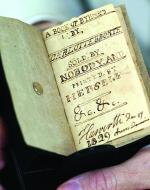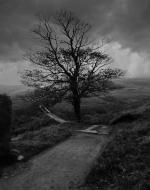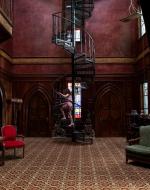Created by Caroline Brown on Thu, 11/10/2022 - 16:28
Description:
Charlotte Brontë was haunted by death that seemingly followed her everywhere she went. Many fall apart simply at the thought of losing the amount of people Charlotte lost in her few years on this planet. Where Charlotte could have fallen, we see her thrive through her writing. The analysis of Charlotte Brontes use of the supernatural, and her creation of the red room, is vital to understanding Charlotte as a person and author and its ongoing influence today.
Branwell Brontë, "The Brontë Sisters," 1834, Wikimedia Commons, 2022.
The first image depicts the three Bronte sisters and Branwell, who created the painting. The three surviving sisters were surrounded by death, having two of their sisters die when they were children. They watched their family perish around them, but reacted in different ways to these deaths. Anne and Emily resorted to the religious ideology to find comfort in death while Charlotte turned to the supernatural to cope with the death that surrounded her life. Charlotte was the longest living Brontë sibling, and she watched everyone die around her, which is what makes this image so powerful. Here we see her positioned closest to Branwell, who seems to loom over her head. This image becomes even more powerful because Branwell died before Charlotte. This image can be interpreted as Charlotte with death surrounding her, always looming over her head. Branwell's death greatly affected Charlotte as a person and asa writer. .
Charlotte Brontë, "Charlotte Brontë Miniature Books," 1840, The British Library, 2022.
This second image depicts one of Charlotte Brontë's miniature books, a staple in the lives of all three sisters. These books were never meant for publication, which allowed the children to have full creative freedom when writing them. We are seeing an inside look into the imaginative world of the Brontë siblings. They created these books out of their explorations through the moors and with their advanced intelligence. These miniature books were filled with short stories and poems that created a world for their toy soldiers. These stories follow the toy soldiers through adventures in their kingdoms, where each sister has her own territory. When looking at Charlotte's miniature books, we can see ideas of the supernatural start to peak through the writing. The characters such as her own toy soldier interact with creatures that are not human, such as animals and other people who do not fall into the “human” category (British Library, 2021). This is the first hint into Charlotte's interest in the supernatural that we will continue to see in her later writings, such as Jane Eyre and poetry. These miniature books included mythologies and a plethora of diverse characters who continuously challenge the regular religious ideology at the time.
"Haworth Moors," from "On the Brontës," The British Library, 2021.
This third image depicts the Moors in the evening time; its dark essence can be felt through the screen. Charlotte ran through these moors as a child. We can see in the photo how they are filled with trees and long rolling hills. We know that Charlotte had her toy stories run through these hills. This picture depicts the darkness that could come out while in the moors. Charlotte includes nature in lots of her writings, which could have come from this environment. Walking for miles in the moors influenced Charlotte and contributed to the darkness that is weaved throughout Jane Eyre. Many have visited these moors and have experienced moments where it seems like past and present come together into one moment (Mangan, 2021). It is imperative to look at the environment that Charlotte grew up in to understand why she created supernatural elements such as the ones depicted in Jane Eyre.
F. D. Bedford, "The Red-Room Was a Square Chamber," Jane Eyre (1847), by Charlotte Brontë, for a 1932 Thomas Nelson and Sons edition.
This fifth image is that of a modern adaptation of Jane in the Red Room. It was interesting to watch this scene as we see the stark contrast of Jane’s white complexion against the deep red furniture and drapes along the wall. Seeing this scene brought more life to the story and brings Charlotte's true vision to light. I think it is very imperative to analze the colors in this scene, as we do not see this in the black-and-white renditionby Bedford. Here her white dress could represent purity, but as she spends more time in this room, she becomes disheveled, and overcome in the environment that she is in. The whole is being enveloped by red, the evil that surrounds Jane. Hvaing a modern adaptation allows the supernatural elements to peek through even more. These memories that Jane develops in the Red Room stay with her for the rest of her journey throughout Jane Eyre, showing how the supernatural stayed with Charlotte, who could not escape the ghosts of her loved ones.
Still from Haunting of Hill House, Director Mike Flanagan, 2018 Adaptation of Shirley Jackson's Haunting of Hill House.







